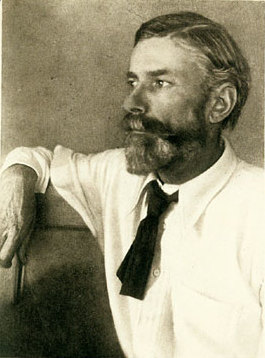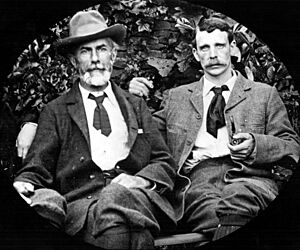Edward Carpenter facts for kids
Quick facts for kids
Edward Carpenter
|
|
|---|---|
 |
|
| Born |
Edward Carpenter
29 August 1844 |
| Died | 28 June 1929 (aged 84) |
| Resting place | Mount Cemetery, Guildford, England |
| Occupation |
|
| Partner(s) | George Merrill (1891–1928) |
| Signature | |
Edward Carpenter (born August 29, 1844 – died June 28, 1929) was an English writer, poet, and thinker. He believed in a better society for everyone, which is called a utopian socialist. He was also a philosopher, meaning he thought deeply about life and ideas.
Carpenter was an early activist who worked for fairness and equality for all people. He also supported prison reform, which means making prisons better. He was a vegetarian and spoke out against animal testing. One of his most famous ideas was that civilisation could be like a sickness that societies go through.
His ideas influenced famous writers like D. H. Lawrence and E. M. Forster. Forster's novel Maurice was even inspired by Carpenter's life.
Contents
Early Life and Education
Edward Carpenter was born in Hove, England. He went to Brighton College, where his father was a governor. From a young age, Edward showed a talent for playing the piano.
He later became very good at academics and earned a spot at Trinity Hall, Cambridge University. There, he was influenced by a Christian thinker named F. D. Maurice. Edward also formed very close friendships, including one with Edward Anthony Beck, which he described as having "a touch of romance." This friendship ended, which made Carpenter very sad. He finished his studies in 1868. After university, he became a curate (a church assistant) in the Church of England, but he didn't feel a strong connection to it.
In 1871, Carpenter was asked to teach the royal princes, including George Frederick (who later became King George V). He turned down the job, and his friend John Neale Dalton took it instead.
Over the next few years, Carpenter felt more and more unhappy with his life in the church and university. He thought Victorian society was often fake. He found comfort in reading poetry, especially the works of Walt Whitman. He said Whitman's poems caused a "profound change" in him. He even visited Whitman in America in 1877.
Moving North and New Ideas
In 1874, Edward Carpenter left the church and moved to Leeds. He became a lecturer for the University Extension Movement. This group wanted to make education available to more people, especially those in poorer areas. He taught about astronomy, ancient Greek women, and music. He hoped to teach working-class people, but most of his students were from the middle class.
Feeling disappointed, he moved to Chesterfield and then to Sheffield a year later. In Sheffield, he met many manual workers and started writing poetry.
When his father died in 1882, Edward inherited £6,000. This money allowed him to stop lecturing and live a simpler life. He first lived on a small farm near Sheffield with Albert Ferneyhough, who made scythes, and his family. In 1883, Edward and Albert, along with Albert's family, moved to Millthorpe, Derbyshire. There, Carpenter built a new house and started a small garden. They also made and sold leather sandals, inspired by designs from India.
Carpenter helped make the phrase "Simple Life" popular. He wrote about it in his essay Simplification of Life. His simple lifestyle and house at Millthorpe influenced the "Garden City" movement, which aimed to create planned communities with green spaces.
In Sheffield, Carpenter became more involved in social change. He joined the Social Democratic Federation in 1883, a group that wanted to improve society. He worked on projects that showed the poor living conditions of factory workers. He later joined the Socialist League with William Morris.
In 1883, Carpenter published the first part of Towards Democracy. This was a long poem where he shared his ideas about "spiritual democracy" and how people could create a fairer society. The poem was inspired by Whitman's poetry and ancient Hindu writings like the Bhagavad Gita. More parts of Towards Democracy were published over the years, with the complete edition coming out in 1905.
From 1888 to 1889, Carpenter lived with Cecil Reddie. He also helped Reddie start Abbotsholme School in Derbyshire. This school was a new, progressive kind of school, different from traditional ones.
In 1889, Carpenter wrote about the terrible pollution in Sheffield. He said the thick smog was like smoke from Judgment Day and that it was harming the lives of thousands of people. He pointed out that many adults and children struggled to breathe and were dying from illnesses caused by the pollution.
Travels to India
Carpenter became very interested in Hindu philosophy. In 1890, he traveled to India and Ceylon (now Sri Lanka). He talked with a wise teacher named Ramaswamy. These conversations made him believe that a better society would not only change how people lived but also how they thought.
He wrote about his travels in a book called From Adam's Peak to Elephanta: Sketches in Ceylon and India, published in 1892. His spiritual ideas in this book later influenced the Russian writer Peter Ouspensky.
Life with George Merrill
When Carpenter returned from India in 1891, he met George Merrill. George was a working-class man from Sheffield, 22 years younger than Carpenter. After the Ferneyhough family left Millthorpe in 1893, Merrill became Carpenter's close companion. They lived together from 1898 and remained companions for the rest of their lives. George Merrill grew up in the poor areas of Sheffield and had little formal education.

Carpenter had many famous friends, including writers, activists, and thinkers. Some of them were Henry S. Salt, Havelock Ellis, Ben Iden Payne, Bruce and Katharine Glasier, John Addington Symonds, and Olive Schreiner.
E. M. Forster was a close friend and often visited Carpenter and Merrill. Forster later said that a visit to Millthorpe in 1913 inspired him to write his novel Maurice. The close friendship between Carpenter and Merrill influenced the relationship between characters in Forster's book.
The writer D. H. Lawrence read the manuscript of Maurice. Carpenter's simple country life and the story in Maurice influenced Lawrence's 1928 novel Lady Chatterley's Lover.
Later Life
In 1902, Carpenter published Ioläus: An Anthology of Friendship. This book was a collection of poems and writings.
In 1915, he wrote The Healing of Nations and the Hidden Sources of Their Strife. In this book, he argued that wars and problems in Western society came from unfair class differences and social inequality.
Carpenter also believed in the Christ myth theory, which suggests that the story of Jesus is based on older myths. His book Pagan and Christian Creeds was published in 1921.
When George Hukin died in 1917, Carpenter felt less connected to the North of England. In 1922, he and Merrill moved to Guildford, Surrey. On Carpenter's 80th birthday, he received a special album signed by every member of the Labour Government at the time, including Prime Minister Ramsay MacDonald.
In January 1928, George Merrill died suddenly. This was a great loss for Carpenter. He sold their home and moved in with his carer, Ted Inigan. In May 1928, Carpenter had a stroke. He passed away 13 months later, on June 28, 1929, at the age of 84. He was buried in the same grave as Merrill in Mount Cemetery in Guildford.
His obituary in The Times newspaper called him "Edward Carpenter, Author and Poet."
His Influence

Carpenter wrote letters to many important people in politics and culture. These included Annie Besant, Isadora Duncan, Mahatma Gandhi, William Morris, and Olive Schreiner.
He was also friends with Rabindranath Tagore and Walt Whitman. The writer Aldous Huxley recommended Carpenter's ideas in his own book. Modern art critic Herbert Read said Carpenter's writing helped him become an anarchist.
Leslie Paul was influenced by Carpenter's work and shared his ideas with the scouting group he started, The Woodcraft Folk. Algernon Blackwood also admired Carpenter's writings.
Fenner Brockway, a political figure, said in Carpenter's obituary that he was "the greatest spiritual inspiration of our lives." He called Towards Democracy their "Bible." Ansel Adams, a famous photographer, also admired Carpenter's writings. Emma Goldman, a well-known activist, said Carpenter's books influenced her thinking.
Edward Carpenter was sometimes called "the English Tolstoy" because of his similar ideas. Tolstoy himself thought Carpenter was a worthy follower of great thinkers like Thomas Carlyle and John Ruskin.
His Ideas Live On
After his death, many of Carpenter's writings were not printed anymore and were mostly forgotten. However, in the 1970s and 1980s, historians like Jeffrey Weeks and Sheila Rowbotham became interested in his work again. Some of his books were reprinted.
Carpenter was against pollution and cruelty to animals. Because of this, some historians say his ideas were ahead of their time and predicted the modern Green and animal rights movements. He has been called the "Saint in Sandals" and the "gay godfather of the British left."
Written Works (Selected)
| The Religious Influence of Art | 1870 |
| Narcissus and other Poems | 1873 |
| Moses: A Drama in Five Acts (later revised as The Promised Land, 1911) | 1875 |
| Modern Money-Lending and the Meaning of Dividends: A Tract | 1885 |
| England's Ideal: And Other Essays on Social Subject | 1887 |
| Chants of Labour: A Song Book of the People with Music | 1888 |
| Civilisation: Its Cause and Cure | 1889 |
| From Adam's Peak to Elephanta: Sketches in Ceylon and India | 1892 |
| A Visit to Gñani: from Adam's Peak to Elephanta | 1892 |
| Homogenic Love and Its Place in a Free Society | 1894 |
| Marriage in Free Society | 1894 |
| Love's Coming of Age | 1896 |
| An Unknown People | 1897 |
| Angels' Wings: A Series of Essays on Art and its Relation to Life | 1898 |
| Iolaus: Anthology of Friendship | 1902 |
| The Art of Creation | 1904 |
| Prisons, Police, and Punishment: An Inquiry into the Causes and Treatment of Crime and Criminals | 1905 |
| Towards Democracy | 1905 |
| Days with Walt Whitman: With Some Notes on His Life and Work | 1906 |
| Sketches from Life in Town and Country | 1908 |
| Non-Governmental Society | 1911 |
| The Drama of Love and Death: A Study of Human Evolution and Transfiguration | 1912 |
| George Merrill, A True History | 1913 |
| Intermediate Types Among Primitive Folk: A Study in Social Evolution | 1914 |
| The Healing of Nations | 1915 |
| My Days and Dreams, Being Autobiographical Notes | 1916 |
| The Story of My Books | 1916 |
| Never Again! | 1916 |
| Towards Industrial Freedom | 1917 |
| Pagan and Christian Creeds: Their Origin and Meaning | 1920 |
| The Story of Eros and Psyche | 1923 |
| The Psychology of the Poet Shelley | 1925 |
Chants of Labour was a songbook for people who believed in socialism. Carpenter asked for contributions to this book from others. It included works by John Glasse, Edith Nesbit, John Bruce Glasier, Andreas Scheu, William Morris, Jim Connell, Herbert Burrows, and more.
See also
 In Spanish: Edward Carpenter para niños
In Spanish: Edward Carpenter para niños
- List of Christ myth theory proponents




